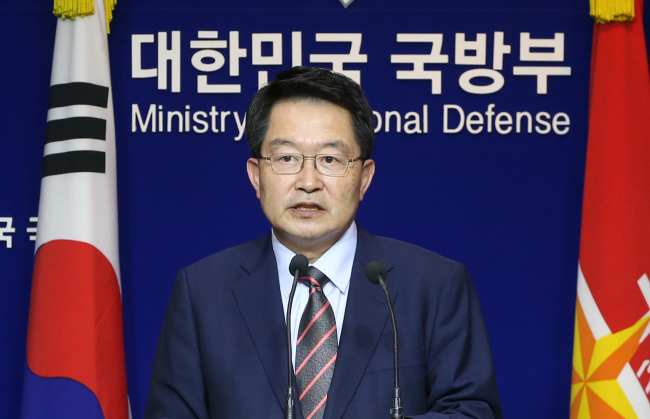Seoul has earmarked 38.95 trillion won ($32.7 billion) in its proposal for next year’s defense budget, an increase of 4 percent from the previous year, as it seeks to beef up defense capabilities to better counter North Korea’s evolving military threats.
“To realize a robust security, we have reflected the security situations, including North Korea’s recent provocations, and our strong resolve to address them in our budget planning for next year,” Vice Defense Minister Baek Seung-joo said during a press briefing on the budget plan to be submitted to the National Assembly on Friday.
“To realize a robust security, we have reflected the security situations, including North Korea’s recent provocations, and our strong resolve to address them in our budget planning for next year,” Vice Defense Minister Baek Seung-joo said during a press briefing on the budget plan to be submitted to the National Assembly on Friday.

“The increase in defense spending for next year is 4 percent, higher than the 3 percent increase of total government spending for next year.”
The defense budget proposal focused on strengthening deterrence against the North, which has ratcheted up military tensions by conducting an ejection test of a submarine-launched ballistic missile in May 2014 and a set of provocations along the border last month.
The government set aside 11.68 trillion won for its budget to improve overall defense capabilities, an increase of 6.1 percent from a year ago.
In particular, it earmarked more than 3 trillion won to strengthen frontline defense around the Demilitarized Zone, marking an increase of 40.6 percent from the previous year. The money is to be spent on bolstering artillery detection radars, drone-based surveillance capabilities and striking assets such as K-9 self-propelled howitzers and multiple rocket launchers.
The government hopes to spend 1.67 trillion won, an increase of 5.4 percent from a year ago, on antisubmarine capabilities. Last month, the North, in a “quasi-state of war,” mobilized a massive fleet of submarines, showing off its underwater warfare capabilities.
Also noteworthy in the budget plan is a spike in the expenditure for constructing the Korea Air and Missile Defense system and the Kill Chain preemptive strike architecture that will form the basis of Seoul’s capabilities to counter Pyongyang’s missile and nuclear threats.
For the KAMD and Kill Chain programs, Seoul set aside 1.5 trillion won, an increase of 64.5 percent from the previous year.
“We increased the budget to speed up the construction of the Kill Chain and KAMD to respond to North Korea’s asymmetric military threats and to bolster our defense of frontline outposts through enhancing key assets such as mid-range guided weapons,” Baek said.
To continue the efforts to lay the groundwork for peaceful unification, Seoul pledged to focus on the restoration of the Gyeongwon railroad which in the past ran from Seoul to North Korea’s eastern city of Wonsan, and on the construction of the infrastructure for inter-Korean economic cooperation and exchanges.
For the railroad project, Seoul set aside 150.8 billion won. It also earmarked 32.4 billion won for the construction of a DMZ peace park and 66.6 billion won for enhancing the infrastructure for the inter-Korean industrial park in the North Korean border city of Gaeseong.
By Song Sang-ho (sshluck@heraldcorp.com)












![[Today’s K-pop] BTS pop-up event to come to Seoul](http://res.heraldm.com/phpwas/restmb_idxmake.php?idx=644&simg=/content/image/2024/04/17/20240417050734_0.jpg&u=)




![[KH Explains] Hyundai's full hybrid edge to pay off amid slow transition to pure EVs](http://res.heraldm.com/phpwas/restmb_idxmake.php?idx=652&simg=/content/image/2024/04/18/20240418050645_0.jpg&u=20240419100350)

![[Today’s K-pop] Zico drops snippet of collaboration with Jennie](http://res.heraldm.com/phpwas/restmb_idxmake.php?idx=642&simg=/content/image/2024/04/18/20240418050702_0.jpg&u=)